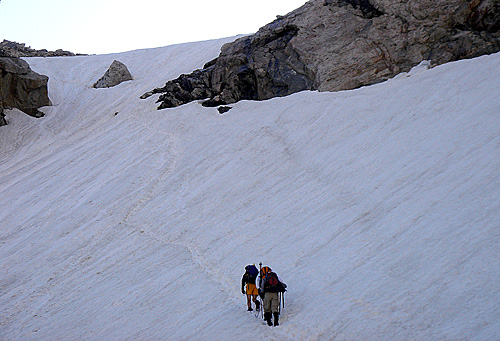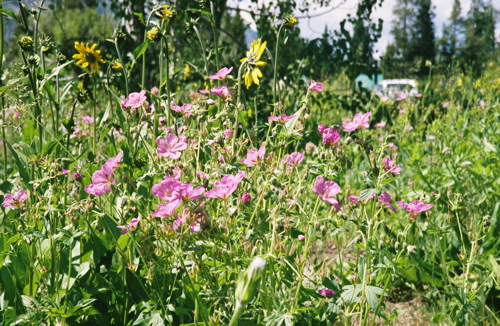
|
The end of a long day. Heading to base camp across the last, difficult snowfield. Friday, July 8 Galbraith asked me to come up with a thought for the day on this, the day we set out to climb the big mountain. Here it is:
Our aim that morning was on the summit of The Grand Teton, the highest mountain in the Teton chain. For experienced climbers, the peak is not difficult. Let's make that clear. But for us, it was to be our first high-altitude technical climb. We knew it would not be easy. The first documented climb of The Grand occurred on August 11, 1898. The climbers were William Owen, Franklin Spalding, John Shive and Frank Peterson. The route we climbed is the Owen-Spalding Route, named for these early mountain explorers. The first people to climb The Grand may well have been Native Americans climbing centuries ago without harnesses or carabiners or helmets. On the morning we made the summit, I asked Christian Santelices who he thought climbed the mountain first. He pointed to a nearby false summit where ancient people had erected stone altars. “See how close they were,” he said. “If they could make it that far, why couldn't they make it to the top?”
On this Friday, the plan was to leave from the Lupine Meadows Trail Head and hike up to the lower saddle of The Grand. We would camp there overnight and then proceed on Saturday morning to the summit. We had packed the night before, and we had done so thoughtfully. The challenge was to take everything one needed but not an ounce that wasn't necessary. Our hike up to base camp would cover eight miles over terrible terrain. It would move us in elevation from about 7,000 feet at the start of the hike to 11,600 at base camp. We debated how much our loaded packs weighed. The real weight was probably about 25 pounds, but that still felt heavy at the end of the day. Our packs contained climbing gear, food, water, clothing, cameras, film and so on. We began at 10 a.m. on a warm Friday morning, heading up a well-tended trail through sunny hillsides and wildflowers. In early July in the Tetons, the flowers are at their best. Just before noon, we came to a spot where the well-tended trail ran into a field of boulders and essentially disappeared. Going up and coming down, these boulder fields were a challenge that grew worse with fatigue. I tried walking close behind Mark so I could imitate his effortless steps. We ate lunch on the far edge of the first boulder field. It was a lovely spot beside a meadow and a small stream in a sort of bowl. Just above us, a waterfall cascaded down. Mark warned us we had covered some distance, but the real elevation gain was just about to begin. As we walked through that afternoon, our legs felt heavier, and so did our packs. In the dry mountain air, my throat hurt. I found it difficult to swallow. We trudged upward, growing wearier and struggling to breathe as the mountain air thinned. Hours later, we came to another broad boulder field that led to a long, uphill snowfield and a ridge above it. “That's where we're headed,” Mark said. “I know it may look close, but we've still got a long way to go.” There were sheer cliffs to the right and the Middle Teton Glacier to the left and no path except straight up the steep bank of snow. We donned helmets and gaiters, got out our ice axes and roped up. We were walking uphill under full packs on a snow-covered incline of roughly 40 degrees at an elevation of about 11,000 feet. The sun blazed down, its snow-reflected glare heating us in spite of the ice. We arrived in camp about 6:30 p.m., more than eight hours after starting. I dropped my pack on a large rock and collapsed onto it and checked out the camp as I rested. The “hut” was a large tent with a wooden floor. Inside the tent and out of the wind, someone was boiling water for dinner. A mass of rock just south of the tent hid the toilet facilities. Each of us received upon arrival a pouch containing a bag, toilet paper and a foil bag to be used the next day to carry our bodily wastes back down the mountain. We were told to walk carefully in the camp to avoid the tender tundra vegetation just then turning green. Tiny blue flowers carpeted the ground. The view from the privy was one of the most spectacular I have seen. We ate dried soup and boil-in-bag entrees. I've rarely had a more welcome meal. But Tom Kimbrough ate nothing, a common symptom of altitude sickness. He had been coughing throughout the afternoon hike, another common symptom. We had the sense that our guides were watching Tom carefully. “Let us know if that cough becomes productive,” Mark said to Tom. As darkness fell, the temperature plummeted. Our guides huddled out of earshot for a brief strategy session and then met with us. “What you should concentrate on tonight is to get your gear together so you can be ready to leave early, before daylight,” Mark said. “Lots of people don't sleep well at this altitude, but you should try and get as much rest as you can, even if you can't sleep. Just lie still and relax as much as possible.” Before dark, we climbed into sleeping bags. I wore earplugs, but in spite of them I heard Tom's rasping cough all night. It had a sharp and painful sound that got worse as the minutes ticked by. None of us slept much. |
By Dolph Tillotson
Climbing Teton
1 - Just Have Fun
2 - The Climbers
3 - Tuesday
4 - Wednesday
5 - Thursday
6 - Friday
7 - Summit Day 8 - Time is Short The relationships are more important than the climb. Resources See also |
© 2005 The Galveston County Daily News. All rights reserved. A Galveston Newspapers Inc. Publication. |


